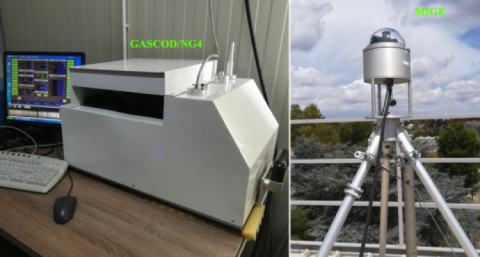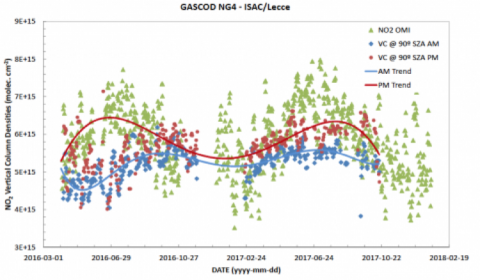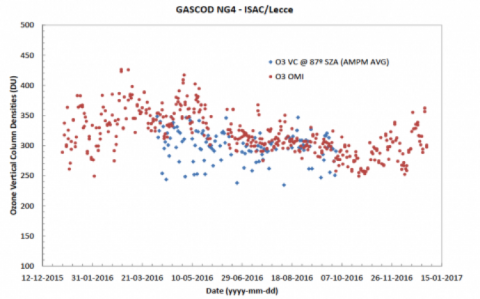NO2 and O3 DOAS (Differential Optical Absorption Spectroscopy system) measurements at the Observatory (ECO) in Lecce (ISAC-CNR)
j F Y in Uncategorized
The DOAS (Differential Optical Absorption Spectroscopy) observational technique is based on a modified form of the Bougert-Lambert-Beer law relating the attenuation of radiation to the properties of the material through which the light is travelling, in our case the atmosphere. The peculiarity of DOAS is the differential feature that remove the low frequency structures of the absorbing species, building a mean function of the measured spectral range, subtracting it from the original one and multiplying the result for a normalization factor. The main advantage of this approach is the possibility to use spectral measurements not radio-metrically calibrated, since the differentiation process removes the common features of the analysed spectrum and the one used as reference, highlighting the difference of the two spectral series. The DOAS system used at ECO observatory at Lecce consists of the GASCOD/NG4 (Gas Analyzer Spectrometer Correlating Optical Differences/ new Generation Mod.4) and the MIGE (Multiple Input Geometry Device) platform, which are shown in Figure 2.1.
Fig. 2.1) DOAS system at the observatory ECO I-AMICA in Lecce
Figure 2.2 reports the seasonal variation of NO2 vertical columns as measured by the GASCOD/NG4-MIGE system. The analogues measurements carried out with the NASA OMI (Ozone Monitoring Instrument) satellite instrument are also plotted. The values are referred to solar zenith angles of 90° at sunrise (AM) and sunset (PM). It can be noted that the PM observations are systematically higher than the AM vertical columns. The AM/PM variation is mainly due to the photochemical activity of NO2 that is produced during the day through the reactions:
N2O5 +hv –> NO2 + NO3 NO + O3 –> NO2 + O2
and removed during the night thanks to:
NO2 + O3 –> NO3 + O2 NO2 + NO3 + M –> N2O5 + M
The photochemistry is responsible for the yearly maxima and minima occurring in summer and winter respectively. Similarly, the time series for O3 total columns from NG4 and OMI are plotted in Figure 2.3. The considered period is shorter than in Figure 2.2, and it does not allow for an appreciation of the O3 seasonal behaviour that present the maximum value in spring and the minima in autumn. Since the beginning of its history, DOAS evolved in many aspects, starting from the measurements obtained in active mode, using an artificial source of radiation placed at a certain distance of the sensor unit (Open Path configuration), in order to obtain the mean concentration along the measurements path.
Fig. 2.2) Seasonal variation of NO2 vertical columns as measured by the GASCOD/NG4-MIGE system.
Fig. 2.3) Seasonal variation of O3 vertical columns as measured by the GASCOD/NG4-MIGE system.
The zenith sky passive mode, using the sun light as radiation source, was the following step aiming to characterize mainly the low stratospheric compounds from a climatological point of view. In the last 10 years, the MAX-DOAS (Multi AXis-DOAS) configuration that make use of measurements obtained for different elevation angle of the instrument pointing device, is deeply used for the profiling of tropospheric compounds and air quality assessment. For the Open Path configuration, the retrieval of the main concentration along the optical path is quite easy since the distance between emitter and receiver is known. In contrast, for the passive mode configurations (Zenith-sky and MAX-DOAS) the computation of the main concentrations of the analysed species need the help of a radiative transfer model in order to evaluate the distance travelled by the photons before reaching the spectrometric system. The obtained values are primarily function of the sun elevation then of the actual distribution of the atmospheric compounds and many others parameters. This geometrical factor (called Air Mass Factor -AMF) correct the outputs of the DOAS algorithms – the so-called Slant Column Densities (SCDs) – in order to obtain the vertical columns (VC) of the selected tracer. In addition, the AMFs with the SCDs series allows for the retrieval of the vertical distribution for the main atmospheric absorbers such as nitrogen dioxide (NO2) and ozone (O3). For MAX-DOAS configuration this feature is extended to weak tropospheric absorbers.









